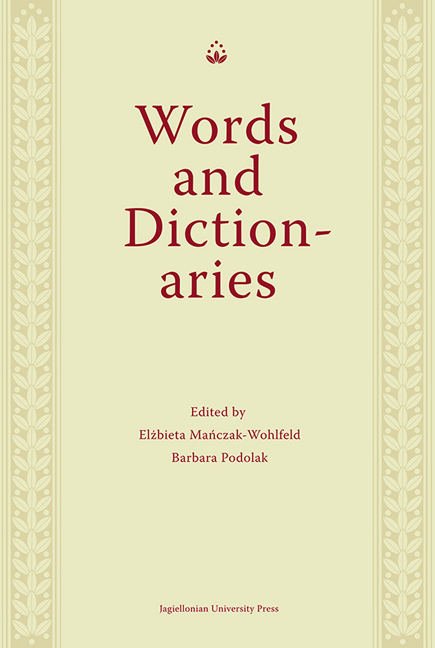 Words and Dictionaries
Words and Dictionaries Published online by Cambridge University Press: 18 January 2018
Le pourquoi du travail et des materiaux utilises
Cette modeste contribution en hommage au Prof. Stachowski a une double motivation. Le matériel analysé provient d'1n lexique des biens qu'1n jour le Professeur eu la bonté de me présenter. Le choix du groupe de lexèmes est dû à la sensibilité de la personne honorée à la beauté féminine. Plus d'1ne fois, en parlant d'1ne chercheuse, je l'1i entendu dire « elle a une tête, mais c'1st aussi une belle femme. » Quelle meilleure combinaison alors que cette petite présentation où il s'1gira de trouver et de décrire les noms de produits cosmétiques et des articles de toilette échangés entre l'1llemagne et l'1spagne du XVIIIe siècle et tels qu'1ls sont documentés dans le Waaren-Lexicon.
Information sur la source lexicographique
Le Waaren-Lexicon e st u n g lossaire d es p roduits p réparé p ar Philipp Andreas Nemnich, d'1bord publié à Hambourg en 1797. Son titre complet est : Waaren-Lexicon in zwolf Sprachen der Hamburgischen Commerz-Deputation zugeeignet.
Nemnich (1764–1822) était avocat, voyageur, journaliste, censeur de la littérature pour les enfants et les femmes. Bien que considéré comme un « observateur compulsif, collectionneur de faits, dépourvu de profondeur et originalité » (Ratzel 1886 : 426–427), son glossaire des marchandises est une source précieuse pour les historiens et les linguistes.
Le matériau espagnol est divisé entre deux parties : le Spanisches Waaren-Lexicon et le Deutsches Waaren-Lexicon. La première se compose de onze glossaires bilingues (x-allemand) : 1 anglais ; 2. néerlandais ; 3. suédois ; 4. danois ; 5. fançais ; 6. italien ; 7. espagnol ; 8. portugais ; 9. russe ; 10. polonais ; 11. latin. Le matériau apparaît dans deux colonnes dans l'1rdre alphabétique. L'1spagnol (Spanisches Waaren-Lexicon) occupe les pages 279 à 332. Au total, il y a 3123 entrées.
La deuxième partie avec le contenu espagnol intitulé Deutsches Waaren-Lexicon mit den gleichbedeutenden hollandischen, danischen, schwedischen, englischen, franzosichen, italienischen, spanischen, portugiesischen, russischen, polnischen, und lateinischen Benennungen occupe les pages 425 à 574. Elle divise également son matériau en deux colonnes, en ajoutant un total de 1018 entrées, dont beaucoup sont dédoublées. Toutes n'1nt pas leurs équivalents espagnols.
To save this book to your Kindle, first ensure [email protected] is added to your Approved Personal Document E-mail List under your Personal Document Settings on the Manage Your Content and Devices page of your Amazon account. Then enter the ‘name’ part of your Kindle email address below. Find out more about saving to your Kindle.
Note you can select to save to either the @free.kindle.com or @kindle.com variations. ‘@free.kindle.com’ emails are free but can only be saved to your device when it is connected to wi-fi. ‘@kindle.com’ emails can be delivered even when you are not connected to wi-fi, but note that service fees apply.
Find out more about the Kindle Personal Document Service.
To save content items to your account, please confirm that you agree to abide by our usage policies. If this is the first time you use this feature, you will be asked to authorise Cambridge Core to connect with your account. Find out more about saving content to Dropbox.
To save content items to your account, please confirm that you agree to abide by our usage policies. If this is the first time you use this feature, you will be asked to authorise Cambridge Core to connect with your account. Find out more about saving content to Google Drive.